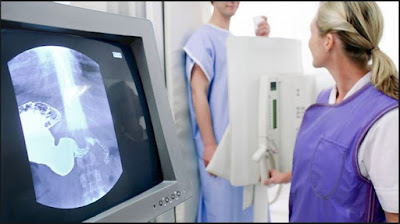Clinical Skills Required for Examination by the American Registry of Radiologic Technologists (ARRT)
 |
| Radiologic Technologist |
- Evaluate the need for and use of protective shielding
- Take appropriate precautions to minimize radiation exposure to patients.
- Restrict beam to limit exposure area, improve image quality and reduce radiation dose.
- Set kilovolt peak (kVp) level, milliamperage (mA), and time (s) or automate exposure system to achieve optimal image quality, safe operating conditions, and minimum radiation dose.
- Prevent all unnecessary persons from remaining in area during x-ray exposure.
- Take appropriate precautions to minimize occupational radiation exposure.
- Wear a personnel radiation monitoring device while on duty.
- Review and evaluate individual occupational exposure reports.
- Warm up the xray tube according to manufacturer’s recommendations.
- Prepare and adjust radiographic imaging system and accessories.
- Prepare and adjust the fluoroscopic imaging system and accessories.
- Recognize and report malfunctions in the radiographic or fluoroscopic imaging system and accessories.
- Perform basic evaluations of radiographic equipment and accessories like lead aprons, collimator accuracy.
- Inspect and clean screens and cassettes.
- Perform startup or shutdown procedures on automatic film processor
- Recognize and report malfunctions in the automatic processor.
- Recognize and report malfunctions in the automatic processor.
- Process exposed film.
- Reload cassettes by selecting film of proper size and type.
- Store film or cassette by selecting film of proper size and type.
- Store firm or cassettes in a manner that will reduce the possibility or artifact production.
- Select appropriate firm and screen combination or grid.
- Determine appropriate exposure factors using calipers, technique charts and tube rating charts.
- Modify exposure factors for circumstances such as involuntary motion, casts and splints, pathologic conditions, or patient’s inability to cooperate.
- Use radiopaque markers to indicate anatomic side, position, or other relevant information.
- Evaluate patient and radiographs to determine if additional projections or positions should be recommended.
- Evaluate radiographs for diagnostic quality.
- Determine corrective measures if radiograph is not of diagnostic quality and take appropriate action.
- Select equipment and accessories for the examination requested.
- Remove all radiopaque materials from patient or table that could interfere with the radiographic image.
Subscribe your email address now to get the latest articles from us









No comments:
Post a Comment